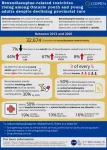(Press-News.org) Perfect noncaloric replacements for sugar and high fructose corn syrup just don’t exist yet. For example, some alternatives have a lingering sweet aftertaste and lack a sugar-like mouthfeel, leaving consumers unsatisfied. Now, researchers in ACS’ Journal of Agricultural and Food Chemistry propose adding blends of nutritionally important mineral salts to make noncaloric sweeteners seem more like the real thing. Taste-testers indicated that these blends gave zero- and low-calorie drinks a better flavor.
Sugar substitutes are often used in sodas, baked goods and frozen desserts, to appeal to people who want lower-calorie or low-sugar treats. But many natural or synthetic noncaloric sweeteners, such as stevia and aspartame, have a delayed sweetness, which lasts long after a food or drink is consumed. These substances also don’t usually have the same mouthfeel as real sugar. Previously, Grant DuBois and colleagues observed that sodium chloride and potassium chloride could accelerate the onset of sweetness and eliminate its persistence for one stevia compound, rebaudioside A. They hypothesized that the salts compress the mucus hydrogel covering taste buds to allow rebaudioside A molecules to get through and then leave more quickly. But high concentrations were needed to achieve the desired effects, which led to off-tastes. So, the researchers wanted to test other mineral salts on commercially available noncaloric sweeteners to see if the products that they are used in could be improved.
In initial tests with a trained sensory panel, the researchers observed that calcium chloride, magnesium chloride and potassium chloride each separately reduced the perceived intensity of rebaudioside A after two minutes. However, again, high amounts of the mineral salt were needed to lower the intensity by more than 30%, which caused unpleasant saltiness or bitterness sensations. Next, mixing the three taste-modifying salts had synergistic effects, allowing the team to use lower amounts of each for the same effect. A blend of the potassium, magnesium and calcium salts reduced the lingering sweetness up to 79% and markedly increased the sugar-like mouthfeel of 10 noncaloric alternatives.
Some panelists still reported a slight saltiness in a few sugar substitute formulations with the all-chloride mineral salt blends. So, the team tested reduced-chloride versions in two commercial zero-calorie colas, resolving the faint salty off-taste issue and greatly improving the taste of the beverages. Additionally, they added salt blends to a reduced-calorie orange juice and a commercial citrus-flavored soft drink made with high fructose corn syrup, which made both beverages taste more like they contained sugar. The researchers say that they have a promising solution for replicating the taste of real sugar in low- and zero-calorie beverages.
The authors are employees of Almendra Americas, LLC and Almendra Thailand, Ltd.; and acknowledge funding from Almendra Thailand, Ltd.
The authors have a U.S. patent on this technology.
The American Chemical Society (ACS) is a nonprofit organization chartered by the U.S. Congress. ACS’ mission is to advance the broader chemistry enterprise and its practitioners for the benefit of Earth and all its people. The Society is a global leader in promoting excellence in science education and providing access to chemistry-related information and research through its multiple research solutions, peer-reviewed journals, scientific conferences, eBooks and weekly news periodical Chemical & Engineering News. ACS journals are among the most cited, most trusted and most read within the scientific literature; however, ACS itself does not conduct chemical research. As a leader in scientific information solutions, its CAS division partners with global innovators to accelerate breakthroughs by curating, connecting and analyzing the world’s scientific knowledge. ACS’ main offices are in Washington, D.C., and Columbus, Ohio.
To automatically receive news releases from the American Chemical Society, contact newsroom@acs.org.
Follow us: Twitter | Facebook | LinkedIn | Instagram
END
A ‘pinch’ of mineral salts helps the noncaloric sweeteners go down
2023-06-15
ELSE PRESS RELEASES FROM THIS DATE:
New tracking device to keep better tabs on wolves
2023-06-15
Keeping up with the journeys of wolves and welfare of wild horses has never been easier. With a GPS wildlife tracker powered by an animal's own movements, University of Copenhagen researchers have solved a problem faced by biologists and wildlife managers seeking to track wild animals year after year: dead batteries.
The wolf’s comeback in Europe has preoccupied people all across the continent over the last years. Where is it? What is its range? What does it live on? The only way to get solid answers to these questions is through GPS tracking. In ...
Nearly 1 in 3 Black adults may develop PAD; disparities in care increase amputation risk
2023-06-15
Statement Highlights:
Nearly 1 in 3 Black adults may develop peripheral artery disease (PAD), compared to about 1 in 5 Hispanic or white adults. If amputation is necessary for treatment, Black, Hispanic and American Indian adults experience lower survival rates and worse quality of life after amputation compared to white adults.
Multiple social, economic and health variables contribute to disparities by sex, race and ethnicity in the development, diagnosis and treatment of PAD.
Opportunities to address disparities include greater focus on prevention in health care systems, ...
Mapping the evolution of E. coli’s main virulence factor offers a refined drug target
2023-06-15
This new work focused on a particular subset of E. coli with a specific capsule - the extracellular barrier that surrounds a bacterium - which scientists have called K1. E. coli with this type of capsule are known to cause invasive diseases such as bloodstream or kidney infections, and meningitis in newborns. This is because this particular cover allows them to mimic molecules already present in human tissues and enter the body unnoticed.
The researchers present evidence that targeting the capsule can be used ...
Only 30% of show horse owners surveyed in Australia agreed with facial hair trimming ban, new study reveals
2023-06-15
New research published in the CABI journal Human-Animal Interactions has revealed that only 30% of show horse owners surveyed in Australia agreed with a ban on the trimming of facial hair prior to its implementation in July 2022.
The research found that when asked if facial hair trimming should be banned in all equine competitions, most disciplines broadly agreed (60.5% to 84.6%) apart from showing with only 22.9% of respondents agreeing with a ban.
Indeed, some who took part in the research also believed that horses did ...
Chronic wound healing using glass
2023-06-15
Researchers at the University of Birmingham have demonstrated that silver retains antimicrobial activity for longer when it is impregnated into ‘bioactive glass’, and shown for the first time how this promising combination delivers more long-lasting antimicrobial wound protection than conventional alternatives.
Bioactive glasses are a unique class of synthetic biomaterials made from silicone and have been used for some years in bone grafting.
Silver has long been known to prevent or reduce the growth ...
Finding out you’re autistic in later life can be a positive experience
2023-06-15
Receiving an autism diagnosis in your 20, 30s, 40s, 50s or even 60s may seem daunting, but a new study from psychologists in Bath and London finds that the link between the age at which someone gets diagnosed has little bearing on their quality of life.
So-called ‘late diagnosis’ for autism has hit the headlines recently thanks to autism campaigner Christine McGuiness. Whereas autism is usually diagnosed in childhood, it is increasing being diagnosed in adults and especially among women.
Parents often wonder if their child finding out they are autistic earlier or later will have an impact on their lives in the long term. Whilst many people who discover they are autistic as adults ...
Rising rates of benzodiazepine toxicity among young people spark concern
2023-06-15
Toronto, ON, June 15, 2023 – The rate of hospital encounters for benzodiazepine-related toxicity rose by 67 per cent for young adults (aged 19 to 24) and 44 per cent for youth (aged 18 or below) in Ontario between 2013 and 2020, according to a new study from ICES and Unity Health Toronto.
Though there was an overall decline of 7 per cent in the provincial rate of benzodiazepine toxicity, this was largely driven by reductions in rates among people aged 35 years and older.
Benzodiazepines are commonly prescribed to treat anxiety ...
How antelopes under threat from the climate crisis have responded to rising temperatures
2023-06-15
The climate crisis is turning the temperature up all over the world, but in southern Africa, the rise has been particularly concerning. Wild animals dependent on delicate ecosystems which are already dry, so that food and water scarcity limits their ability to cope with increased heat, are at serious risk. Scientists studied the behavior of three different species of antelope with overlapping ranges in Namibia to try to understand how animals of different sizes and behaviors adapt to the heat.
“Even the indigenous wildlife, adapted to hot and arid conditions, shows sensitivity to extreme heat,” said Paul Berry of the University of Potsdam, lead author of the study in ...
Dialogues across language and culture
2023-06-15
Teacher talk seems intuitive – the expert imparts knowledge onto novices, who passively receive expertise like a car or machine receives parts at every station on an assembly line. In reality, an effective teacher in an era of dynamic and higher literacies is less of a factory worker and more of an active negotiator who tries to understand where their students are coming from in order to reach them. The language classroom amplifies this challenge where the negotiation not only centers on the knowledge itself but the means of communication for that knowledge. ...
Access to financial services linked to lower COVID mortality rates
2023-06-15
New research shows that some of the best tools to decrease COVID-19 mortality rates weren’t found in the ER, but rather at the bank.
A study of COVID-19 mortality rates across 142 nations has demonstrated a surprisingly strong link between access to formal financial services and lower COVID-19 mortality rates. In fact, it’s proved to be as strong a predictor of lower COVID-19 death rates as several comorbidities are of higher COVID-19 death rates.
“The reduction is surprisingly large, similar in magnitude to, but opposite in direction from, the mortality risks associated with higher rates of lung cancer and hypertension,” says Todd Watkins, ...


